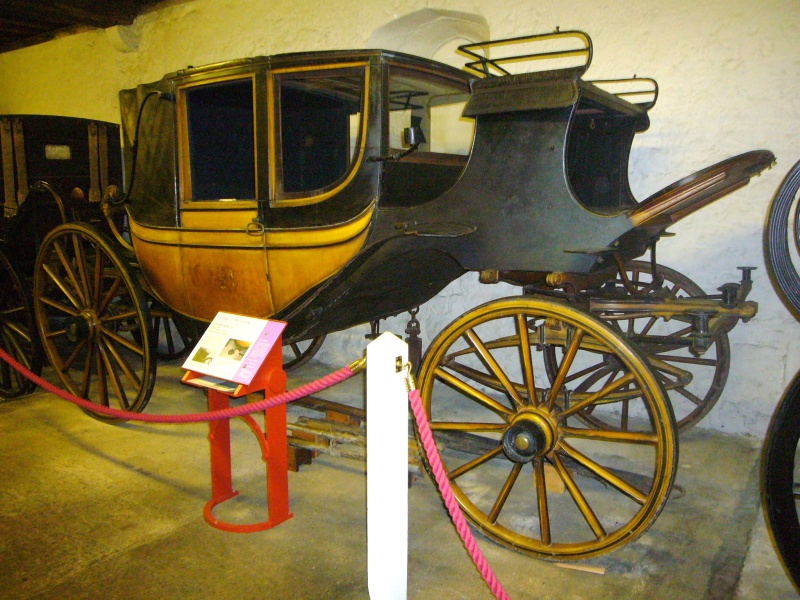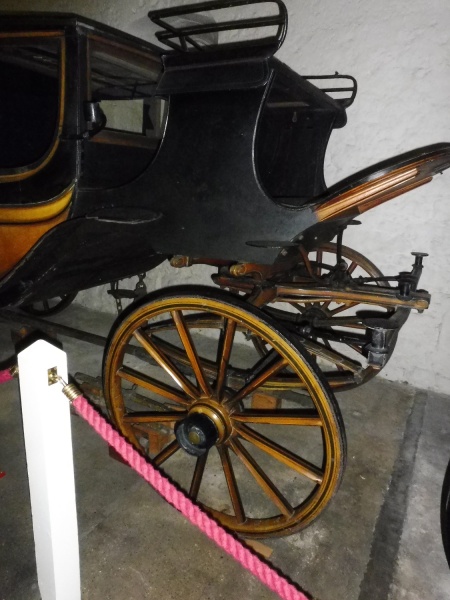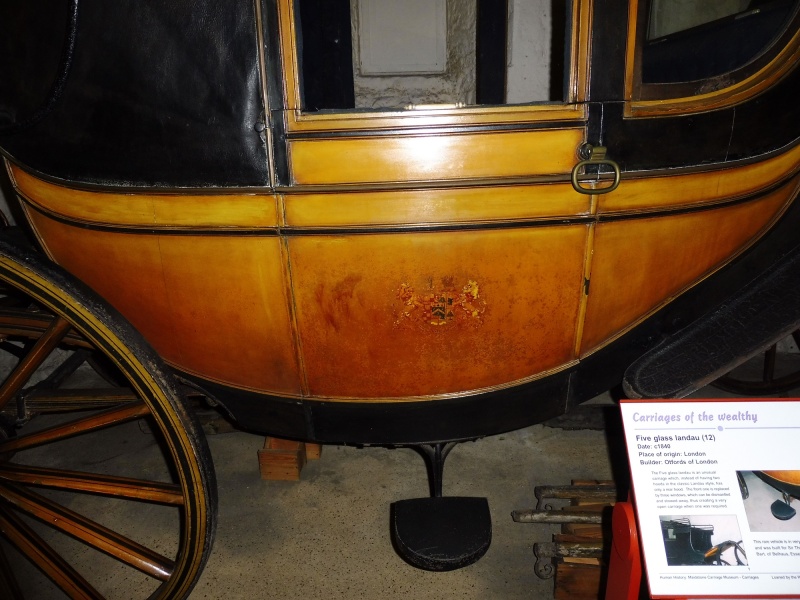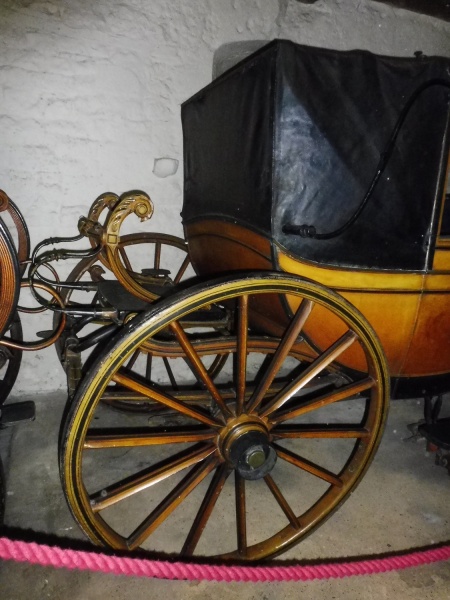Use the dots above to scroll through images.
Listed in 1 collection
Listed at 1 museum
Listed for 1 maker
Quick Details
Carriage Type
Five Glass Landau
Date of Production
Mid 19th century
Materials used
Paint, Wood, Iron, Leather, Bone, Brass, SilkSummary of Five Glass Landau
The Five Glass Landau is an unusual carriage which instead of having two leather heads in the classic Landau style has only a rear head with the front one being replaced by three windows, which can be dismantled and stowed away, thus creating a very open carriage when one was required.
This carriage is in original condition and was built for Sir Thomas Barrett Lennard, Bart, of Belhaus, Essex.
At the start of the nineteenth century landaus were big heavy carriages, open versions of the contemporary coaches. Later in the century, when many more people could afford to own carriages, everyday carriages became smaller and lighter. A successful professional family who could afford to employ a coachman would very likely own a Brougham, a closed carriage for bad weather and night-time use, and a Victoria, an open carriage for use in fine weather. This was an ideal combination but, if they owned a landau, they only needed one carriage for both uses because, with the head raised, it was a closed four seat carriage, but it could be quickly and easily converted to an open carriage simply by lowering the head. Several different styles of everyday landaus were developed. The canoe landau was obviously so named because it has a canoe-shaped body. If a canoe-bodied landau was so small that it could be pulled by one horse it was called a Sefton landau, after the Earl of Sefton for whom the first one was built, and it was considered a breakthrough for a landau to be so small at that time. If the body had an angular profile and a deep foot well it was called a Shelburne landau, after the Earl of Shelburne who had the first of that pattern built. Early landaus had head joints, the hinged stays visible outside the leather of the head, which kept it tightly stretched, but a servant had to get down to raise or lower the head. Many types of head lifts were later developed, spring-assisted mechanisms that were fitted between the head leather and the fabric head cloth ‘which facilitate the closing and opening of the heads, almost as simple in action as the opening or closing of an umbrella or aparasol’ as the celebrated carriage builder G. N. Hooper wrote in 1890.
Dimensions
Height: 8ft 10”
Length: 13ft 8”
Width: 6ft ¾”
Full description
A rather splendid example of a Five Glass Landau by Offord and Sons of London. One of the more unusual types of Landau, this carriage has both style and elegance.The body has a curved underside profile. To the front the curve is slightly shallower and longer, adding more interest to the appearance. A folding leather head on a stylish single hinged iron arm, is at the back. To the front are three folding panels with glass window lights. These stow away behind the coachman’s seat. The frames of the windows in the upper front side panels and the front window are painted in the same yellow as the body.
The doors are hung on concealed hinges and have oval brass handles. Sliding windows are in each door. A brass beading runs along the top edge of the body and round the door frame. Just under the top edge of the body is a wood beading which accentuates the shape of the carriage.
The seat riser sweeps up to a high coachman’s seat. A double iron seat rail with knobs for the attachment of an apron and a leather skirt with painted brass beading surround the seat. Under the seat is a large stowage area. The sloping footboard has a rounded profile. Long sweeping leather splashguards are bolted to the side of the seat riser and to the edge of the footwell.
At the back is a footman’s platform. It is small in comparasion to those on chariots or coaches. The standards and cross bar are carved with an acanthus leaf motif. There are two iron pump handles of an elegant profile. There does not appear to be any sort of step to mount the platform. To mount the inside of the carriage is a large semi-circular step bolted to the underside of the body, its cover is attached to the base of the door. The coachman’s seat is mounted by a single step mounted on a bracket attached to the forecarriage. This has an oval tread.The edges of the wheel hubs are jagged for use as steps. Lamp brackets are attached to the upper front side panels. When the front is folded down these must sit neatly alongside the seat riser.
This Landau has 12 and 14 spoke English pattern wheels with iron tyres on collinge patent axles. The front axle is slightly compassed up. At the front are elliptic springs and at the back two side springs and one cross spring.
The forecarriage is nicely finished with carved components. A splinter bar is compassed down and passes under the futchell. The central roller bolts sit on top of the futchell. A pole is displayed alongside the carriage. There is a drag shoe on the nearside.
Inside the upholstery is in blue silk with a foliate pattern. The cushions are buttoned. Internal furniture is of bone.
The seat riser, upper panels and underside of this Landau are painted black. The side panels, back panel, footboard, wheels and undercarriage are painted yellow with black lining. On each door panel is a family crest.
Inscriptions
On the axle caps: OFFORD & SONS LONDON
Condition report
This carriage is in wonderful original condition. It has areas of paint loss on the metal components and clear signs of wear. The leather head seems in good condition for its age but care ought to be taken if it is ever lowered. A conservation clean and stabilisation of the paintwork would not go amiss.
Access information
This Five Glass Landau is in the care of the Tyrwhitt-Drake Carriage Museum
Maidstone Museum and Art Gallery
St Faith's Street,
Maidstone
ME14 1LH
Picture credit
Maidstone Museum and Bentliff Art gallery / Amy Bracey / Robert Lovell

 Carriage Foundation
Carriage Foundation


